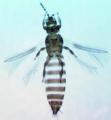Thrips simplex
Recognition data
Distinguishing features
Both sexes fully winged. Body and legs dark brown, tarsi and antennal segment III yellowish brown; fore wings brown, base paler. Head wider than long; 2 pairs of ocellar setae; pair III small, arising just inside anterior margins of ocellar triangle; postocular setae pairs I & III slightly longer than ocellar setae III, pair II minute. Antennae 8-segmented; III–IV with forked sensorium. Pronotum with 2 pairs of posteroangular setae, outer pair slightly shorter than inner pair; posterior margin with 3–4 pairs of setae. Metanotum reticulate medially, reticles elongate on posterior half, most reticles with faint internal markings; median setae short, arising behind anterior margin; campaniform sensilla absent. Fore wing first vein with about 7 setae on distal half; second vein with about 14 setae. Abdominal tergite II with 3 lateral marginal setae; tergites V–VIII with paired ctenidia, on VIII posteromesad to spiracles; tergite VIII posteromarginal comb of microtrichia complete but slightly irregular; pleurotergites without discal setae, but bearing ciliate microtrichia. Sternite II with 2 pairs of marginal setae, III–VII with 3 pairs; sternite II with 1–2 discal setae, III–VII with about 12 discal setae in single row.
Male smaller than female; tergite VIII with no posteromarginal comb; sternites III–VII with large transverse pore plate, discal setae arising laterally.
Related and similar species
The genus Thrips is the second largest genus in the Thysanoptera, and currently includes, worldwide, about 285 species. T. simplex is usually easily recognized as it is one of few species in the genus with short ocellar setae but with markings on the metanotum between the main lines of reticulation. All members of genus Thrips lack ocellar setae I on the head, and they all have ctenidia on tergite VIII posteromesad to the spiracles. Other characters, such as number of antennal segments, number of setae on the fore wing veins, and number of discal setae on the sternites are variable between species (Palmer, 1992; Nakahara, 1994; Mound & Masumoto, 2005).
Taxonomic data
Current valid name
Thrips simplex (Morison)
Original name and synonyms
- Physothrips simplex Morison, 1930: 12
- Taeniothrips gladioli Moulton & Steinweden, 1931: 20
- Physothrips plurisetae Girault, 1933: 2
- Taeniothrips quinani Moulton, 1936: 506
Family placement
Thripidae, Thripinae
Common names
Gladiolus thrips
Biological data
Life history
Breeding mainly on leaves and in leaf axils.
Host plants
Gladiolus, Neomarica, and probably related Iridaceae.
Tospoviruses vectored
None
Crop damage
Feeding results in linear scars on the leaves and flowers of Gladiolus.
Distribution data
Area of origin
Southern Africa
Distribution
Worldwide wherever Gladiolus plants are grown.










